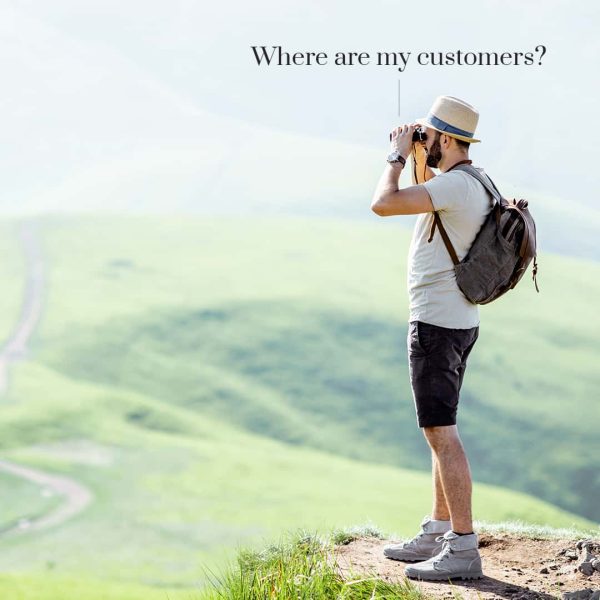Anyone considering working with Google Ads will probably be overwhelmed by the various guides and articles about PPC best practice.
These guides range from genuinely helpful to utterly incomprehensible… As our PPC department is particularly accomplished here at the Tourism Marketing Agency, we thought we’d attempt to write the clearest, most easy-to-read PPC guide for our readers.
What is PPC?
Put simply, pay-per-click (PPC) advertising is a particular kind of digital advertising where you only pay when a user clicks on your ad – if someone sees your ad and doesn’t click, it’s free. While it can get a little complex further down the line, PPC can be split into three not-so-complex categories:
- Paid search– this puts your ad on Google’s search engine results page (SERP), just above the natural, non-paid Google results. We’re sure you will have noticed these paid listings at the top of your Google results pages.
- Display advertising– this puts your ad on the Display Network, across a range of different websites.You can use display to prospect new customers who Google has identified as potentially interested in your service or product, or to re-target people who have been to your website previously.Ever feel like a particular website or brand you like is following you across various different websites? Well, it probably is, and this is because the brand is using retargeting.
- YouTube ads– this refers to the ads that play before you get to see the video you want to watch, as well as the banners that appear across and alongside YouTube videos. You can choose how long your video ad is, whether it’s skippable, and when in the target YouTube video your ad will play.
What are the main benefits of using PPC?
- PPC allows you to reach your target audience immediately, without all of the time and effort that goes into organic search marketing (SEO) or various forms of offline advertising.
- You can set your own ad budget, ensuring you never spend more than you can afford. This can be as little as a penny, and you can pause your campaigns whenever you like.
- The results, the successes (and failures) are very easy to measure and analyse. Every click is counted and the user’s journey is tracked through the site. If they convert as a result of your ad, you’ll be able to tell. This can help you get a clear idea of which ads are performing best for your target audience, allowing you to finetune your ads over time.
- Data gained from Google Ads can actually inform other aspects of your business as the keywords and search volume data can improve and streamline your SEO and content marketing strategies.
- You can specify when and how you’d like your ads to appear, allowing you to target your desired audience at specific times of day or specific devices when they are more likely to make a purchase or enquiry. For example, while people may browse on their phone during the morning commute, they are perhaps more likely to book a holiday on their laptop in the evening, after a conversation with their partner.
How does PPC work?
As PPC can work for a variety of reasons, there is no quick answer to this question. There are several in-depth answers, however, and we’d like to go into more detail below.
PPC offers control
One of the most attractive features of PPC is the level of control it offers. It really is designed to be as flexible as anyone needs it to be. You have control over your budget, the time of your ad display, the location of user you’re targeting with your ad, the type of device your target audience is using, etc. And, with PPC, you can turn it off and on at the click of a mouse. Instantly. If something isn’t working, or you don’t want to waste any more budget on a specific ad campaign, you can stop it immediately.
There are various other ways to control how and when your ads display:
Control your audience with PPC
PPC ads also afford you absolute control over the audience you’d like to target. The Google Ads system is incredibly precise, allowing you to specify your demographic to extremely exact dimensions. Choose gender, age, location, interests, browsing history, and so much more. This is perfect if you know exactly who you want to target, but it’s also great if you don’t and you’d like to experiment with different demographics. Try out a few variations and see which ones work.
Retargeting with PPC
Retargeting could also be considered to be a sub-category of the audience section above, as it is the process of targeting someone who has previously visited your website — perhaps they even made their way to the checkout on your site but abandoned it at the last minute. Retargeting is a great way to reach anaudience who has already proven they are interested in your products or services.
There are different types of ads to suit your campaign
PPC allows you to choose the specific kind of ad you need to suit your purpose. You can choose specific content, images, and other ad features. Rather than all ads just linking to your website, your advertisement can link to your app, your phone number, or include directions to your business. While it’s good to bring users to your site, it’s worth saying that it’s better to put fewer obstacles between your audience and what they’re looking for. Giving them your address or a phone number on the SERP will make their user journey easier, which makes it more likely that they will convert or at least have a positive, streamlined experience with your brand.
Measurement and data analysis with PPC
It’s also worth noting that Google Ads offers an incredible amount of data you can use to analyse your PPC campaigns and plan for future campaigns. By integrating with Google Analytics, You can track users’ journeys through your site and figure out if there are any weaknesses in your website’s user journey. Google Ads’ interface is also full of search volume data about keywords specific to your industry and your specific products. You can use this data to inform your PPC campaigns, but you can also use it to supercharge your other digital marketing activities.
PPC is great for building brand awareness
Because PPC works so well as a direct response channel, its power as a branding tool can be overlooked. A large part of building awareness for your brand simply involves exposing your brand name and logo to as many people as possible. There are various theories that people need to see a brand several times before they become a known entity and are given a certain level of trust. Trust is an important part of every user’s journey to your digital checkout. If they don’t trust you, they will shop elsewhere.
This is where the display advertising part of PPC comes in, as display advertisements are significantly cheaper than paid search advertising. This is because paid search advertising includes a certain amount of intention by the user to find a product, so chances of conversion are much higher and the cost per click reflects this.
For display advertising, all you’re doing is getting little ads (with an image and some text) onto various websites and videos within Google’s display network. The best part is that you only pay for what users click on — not what they see — so you may be getting the brand exposure you need for free in some cases.
What you should know before starting your first PPC campaign
If this blog has piqued your interest in PPC, you may want to start your own campaign. There are plenty of factors to consider and we can run your PPC campaign for you, but we’d also like to empower readers to try it for themselves. The following features should be considered before you start your first PPC campaign:
- Decide on a budget you’re comfortable with and align this to seasonality. For example, travel searches explode after Christmas, when people start thinking about booking their holidays, and the summer months see spikes in searches for last-minute deals. Every business will have nuances to their seasonality, so make sure you not only know your busy periods but also your lead times, as you want to show your ads to people when they’re researching, not just when they’re ready to book.
- Define what your conversions are for your business. Purchases are the bottom line, but there are probably other valuable interactions with your business? Are enquiries or other leads useful? Do phone calls lead to conversions further down the line?
- Work out how much you’re willing to pay for a conversion (think about the ROI involved). Many advertisers don’t consider this. Depending on your industry, and the competition, clicks can be expensive and costs can add up. If operational costs are high and margins are tight, you’ll need to work out if your return on ad spend is worth it. Knowing this can help you pick and choose which products or services should be the focus of your PPC campaign.
- Who is your target audience? Consider this carefully. A luxury travel company might not want to show their ads to a demographic who are most likely to go backpacking — and vice versa. Do you know your customer profile?
- Do you want to drive sales and leads only, or do you want/need to grow your brand? Answering this question will affect the keywords and the website placements you should target. As we discussed above, placing ads on the Google Display Network can be a great, cost-effective way to boost brand exposure.
We hope this guide has helped a few readers better understand PPC. It’s an incredibly precise marketing tool that puts as much control as possible in the account manager’s hands. We hope we’ve encouraged you to try your own PPC campaign, but we also hope we’ve convinced a few readers to allow us to make the most of their campaigns with our experienced PPC team. If you’d like to work with us, or to talk to us about your PPC campaign, please don’t hesitate to get in touch.
Need more free advice?
Chris and his team will send you a weekly email offering high-value insight and advice about a variety of marketing and business development topics related to the tourism industry. We address specific destinations, tours and activities, and the hotel industry. We also provide important travel industry news and updates.

